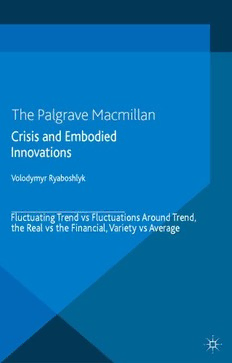
Crisis And Embodied Innovations: Fluctuating Trend vs Fluctuations Around Trend, the Real vs the Financial, Variety vs Average PDF
Preview Crisis And Embodied Innovations: Fluctuating Trend vs Fluctuations Around Trend, the Real vs the Financial, Variety vs Average
Crisis and Embodied Innovations Volodymyr Ryaboshlyk Fluctuating Trend vs Fluctuations Around Trend, the Real vs the Financial, Variety vs Average Crisis and Embodied Innovations This page Intentionally left blank Crisis and Embodied Innovations Fluctuating Trend vs Fluctuations Around Trend, the Real vs the Financial, Variety vs Average Volodymyr Ryaboshlyk This is an English version, revised and enlarged, of the original book published in Ukrainian © Volodymyr Ryaboshlyk 2014 © B.B. Pябошлик, 2010 Neodnoridna Ekonomika (in Ukrainian) Osvita Ukrainy Publishers, 2010 ISBN 978–966–188–154–8 All rights reserved. No reproduction, copy or transmission of this publication may be made without written permission. No portion of this publication may be reproduced, copied or transmitted save with written permission or in accordance with the provisions of the Copyright, Designs and Patents Act 1988, or under the terms of any licence permitting limited copying issued by the Copyright Licensing Agency, Saffron House, 6–10 Kirby Street, LondonEC1N 8TS. Any person who does any unauthorized act in relation to this publication may be liable to criminal prosecution and civil claims for damages. The author has asserted his right to be identified as the author of this work in accordance with the Copyright, Designs and Patents Act 1988. First published 2014 by PALGRAVE MACMILLAN Palgrave Macmillan in the UK is an imprint of Macmillan Publishers Limited, registered in England, company number 785998, of Houndmills, Basingstoke, Hampshire RG21 6XS. Palgrave Macmillan in the US is a division of St Martin’s Press LLC, 175 Fifth Avenue, New York, NY10010. Palgrave Macmillan is the global academic imprint of the above companies and has companies and representatives throughout the world. Palgrave® and Macmillan® are registered trademarks in the United States, the United Kingdom, Europe and other countries ISBN: 978–1–137–47706–4 This book is printed on paper suitable for recycling and made from fully managed and sustained forest sources. Logging, pulping and manufacturing processes are expected to conform to the environmental regulations of the country of origin. A catalogue record for this book is available from the British Library. A catalog record for this book is available from the Library of Congress. Proof is an explanation of the unclear through the clear Zenon from Kition This page Intentionally left blank Contents List of Figures x 1 Introduction 1 Part I Crises and Cycles Driven by Embodied Innovations: Real Aspects 1 1 2 State of the Art Around the Innovations-Crisis Link 13 2.1 L eap-like progress 1 3 2.2 E xplanation by David Ricardo: starting accumulation of new machines 1 4 2.3 M arx and “Marxists”: who has put the cart before the horse? 1 6 2.4 C onvoluted explanations by Schumpeter 1 7 2.5 R eal business cycle theory – right idea and wrong tractability 1 9 2.6 W hether total factor productivity reflects progress 2 1 2.7 F luctuating trend vs fluctuations around trend 2 3 2.8 C onstructive framework proposed 2 6 3 The Innovations-Related Cause of Crises Confirmed by the Prototype Economy 30 3.1 G lobal fisher folk of the twenty-first century 3 0 3 .1.1 S tatement of the problem 30 3 .1.2 O verall slumping S-curve 32 3 .1.3 M ultiple paths to a single finish 39 3.2 F isher folk economy vs Solow economy: golden path vs golden rate 4 2 4 The Innovations-Related Cause of Crises Confirmed by the Concrete Economy 51 4.1 W here are the data? (What are the technologies the gross capital formation forms?) 5 1 4.2 T he simplest step forward 5 3 vii viii Contents 4.3 H eterogeneity matters: answering the question posed by Professor Pissarides 6 0 4.4 P hysical retirement of capital vs financial depreciation 6 1 5 Empirical Support for the Presence of the Innovations-Related Cause in the Current Crisis (Non-financial Roots of the Financial Crisis) 64 Part II Real Cyclical Dynamics in Monetary Environment 6 9 6 Theoretical Basis to Embed the Real into the Financial: Production-Consumption Compromise vs Supply-Demand Paradigm 7 1 6.1 H eterogeneity vs diminishing returns 72 6.2 O bjective marginalism: generalisation of Ricardo 76 6.3 C ommodities produced vs commodities endowed from nowhere 7 9 6.4 P roduction possibility frontier in an economy without capital 7 9 6.5 U tility mountain (field of desires) 83 6.6 F undamental production-consumption compromise 8 5 6.6.1 Q uantities without prices 8 5 6.6.2 A chieving fundamental compromise in a non-market subsistence economy 8 8 6.6.3 A chieving fundamental compromise in a market economy 89 6.7 P roduction possibility frontier in an economy with capital 9 6 6.8 W age-profit compromise 1 06 6.8.1 N ot yield to formalisation 1 06 6.8.2 H ow Great Plague killed off supply-demand for labour 109 6.9 B urnt bridges to supply-demand paradigm 1 11 6.10 C onnection with and evolution of welfare economics 1 18 6.11 T o be constructive 1 24 Contents ix 7 D ynamics of Prices 127 7 .1 D ynamics without inflation 127 7 .2 D ynamics with inflation: non-Keynesian substantiation of the Keynesian easy money 134 8 F rom Interest Rate to Stocks 138 8 .1 I nterest rate for credit: savings and investment 138 8 .2 L everage or gearing: stock market 141 Part III Precursors and Competitors 1 47 9 C oncept of Price: Aristotle vs Marshall 1 49 9 .1 T ail wags the dog 1 49 9 .2 “ Time is price” supported by facts 154 9 .3 S ales tax vs cumulative effect 157 10 S tarting Accumulation vs Primitive Accumulation 1 60 11 D emando-Mania: Keynes and Demand-Deficient Versions of Crisis 166 12 W age-Profit Distortions in Ireland and Ukraine 1 69 13 B ridges to the Cambridge Multisectoral Dynamic Model of the British Economy 172 14 C onclusion 176 References 179 Index 189
